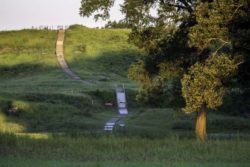Native American Mounds
Louisiana boasts some of the most significant Native American earthen monuments in North America and ranks second only to Mississippi in the number of mound sites.

Photo by Tim Mueller courtesy of the Louisiana Department of Culture, Recreation & Tourism
Eastern approach to Mound A, the largest of the six mounds at Poverty Point.
Louisiana boasts some of the most significant earthen monuments in North America and ranks second only to Mississippi in the number of mound sites in the Lower Mississippi Valley, the cradle of monumental earthworks. Mounds have been a source of fascination as far back as President Thomas Jefferson’s excavations at his Monticello estate in Virginia. Over the years, several explorations were attempted to establish and reestablish the identity of the mound builders, because some antiquarians refused to acknowledge the engineering skills of the Native American inhabitants. Although this issue has been settled, a residual prejudice about who built the mounds remains.
Since the 1950s, the chronological sequence of southeastern prehistoric cultures has been fairly well established. Tweaking the chronology became necessary with the discoveries of the massive earthworks at Poverty Point, followed thirty-five years later by identification of Middle Archaic mounds in the Lower Mississippi Valley. In each case, North American archaeologists initially resisted the earlier date of the mounds, assuming early hunter-gatherers lacked the social organization necessary for building large and sophisticated mound complexes. Through scientific research, the ages of the Poverty Point (ca. 1700-1200 BCE) and Middle Archaic mounds (ca. 4000-2700 BCE) were verified.
Varied Shapes of the Mounds
Mounds exhibit a variety of forms, but conical, dome, platform, and effigy mounds are most common. Some mounds were built in a single episode, while others had multiple stages of construction. Conical mounds tend to be older than platform mounds, but structures were more common on platform mounds. Contrary to popular belief, not all mounds contained human burials nor were they built as high-water refuges. In fact, the first mound builders constructed their earthworks where flooding did not occur. There does not tend to be a singularity of purpose to mound building other than the act itself. It is reasonable to conclude that building earthworks was a communal effort that involved planning, engineering, and organizing labor.
During the five thousand year span of mound creation, there were two cycles of building and stasis. The first stasis lasted for one thousand years, between the end of the Middle Archaic (2700 BCE) and the beginning of the Poverty Point (1700 BCE) periods. The second lasted about five hundred years, between the end of the Poverty Point (1200 BCE) and beginning of the Tchefuncte (500 BCE) periods. Although mounds were not being constructed during either stasis, campsites dating to each period have been found. Indigenous people continued to live in the Lower Mississippi Valley; they just apparently didn’t build mounds then.
Mound sites are more than a conglomeration of earthworks, and a mound is more than a pile of dirt. Each is a monument to the ingenuity and craftsmanship of the indigenous cultures. The variability in the size, volume, morphology, and complexity of mounds is an expression of the aesthetics and social order of their builders.
Troyville Mounds
In 1932-1933 the Great Mound of Troyville in the community of Jonesville was leveled, and its fill was used to build a ramp to the new bridge over the Black River. Originally, the mound was 80 feet tall and 180 feet square at its base; very little of it remained intact when archaeologist Winslow Walker of the Smithsonian Institution arrived to conduct salvage excavations. His short-term work documented extensive data about the mound’s construction. Layer after layer of dirt was sandwiched between split-cane matting secured by wooden stakes to stabilize the mound fill. A wooden plank floor was exposed; palmetto fronds were used for floor cover. A palisade was set along the foot of the mound, and log steps ascended one corner. At least five split-cane domes of unknown function were incorporated into the mound fill. There can be no doubt that engineering played an integral role in building the Great Mound of Troyville. In 2011 the town of Jonesville initiated a reconstruction of the destroyed mound, but present-day builders remain confounded on how to replicate the earthworks using modern machinery.
Ancient Mounds Trail
The northeast region has the best-preserved earthworks in Louisiana, if not in all of North America. Thirty-nine mound sites from this region comprise the inaugural markers along the self-guided Ancient Mounds Trail. Examples of the Middle Archaic, Poverty Point, Tchefuncte, Marksville, Troyville, Coles Creek, and Plaquemine/Mississippian earthworks are available for viewing, though many are on private property. Markers with parking have been placed on the side of the road at the sites. The marker provides a brief summary of the site’s history.
